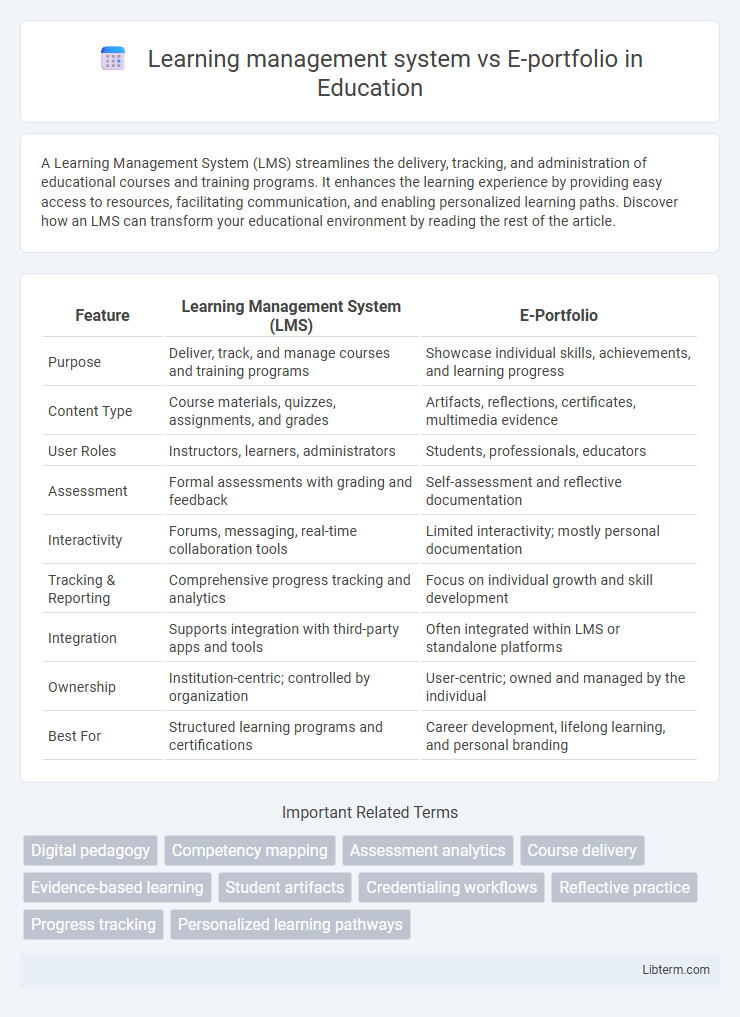A Learning Management System (LMS) streamlines the delivery, tracking, and administration of educational courses and training programs. It enhances the learning experience by providing easy access to resources, facilitating communication, and enabling personalized learning paths. Discover how an LMS can transform your educational environment by reading the rest of the article.
Table of Comparison
| Feature | Learning Management System (LMS) | E-Portfolio |
|---|---|---|
| Purpose | Deliver, track, and manage courses and training programs | Showcase individual skills, achievements, and learning progress |
| Content Type | Course materials, quizzes, assignments, and grades | Artifacts, reflections, certificates, multimedia evidence |
| User Roles | Instructors, learners, administrators | Students, professionals, educators |
| Assessment | Formal assessments with grading and feedback | Self-assessment and reflective documentation |
| Interactivity | Forums, messaging, real-time collaboration tools | Limited interactivity; mostly personal documentation |
| Tracking & Reporting | Comprehensive progress tracking and analytics | Focus on individual growth and skill development |
| Integration | Supports integration with third-party apps and tools | Often integrated within LMS or standalone platforms |
| Ownership | Institution-centric; controlled by organization | User-centric; owned and managed by the individual |
| Best For | Structured learning programs and certifications | Career development, lifelong learning, and personal branding |
Introduction to Learning Management Systems and E-Portfolios
Learning Management Systems (LMS) are digital platforms designed to deliver, track, and manage educational courses and training programs, centralizing content distribution and learner assessment. E-Portfolios are personalized, digital collections of an individual's work, reflections, and achievements, used to demonstrate skills and progress over time. While LMS platforms emphasize course management and structured learning paths, E-Portfolios focus on showcasing personal development and competency evidence across various contexts.
Definition and Core Functions of Learning Management Systems
Learning Management Systems (LMS) are digital platforms designed to deliver, track, and manage educational courses or training programs, providing tools for course creation, enrollment, progress tracking, and assessment management. E-portfolios, by contrast, are personalized digital collections showcasing an individual's skills, achievements, and learning progress, often used for reflection and career development. Core functions of LMS include centralized content delivery, learner performance analytics, communication tools, and administrative tracking, distinguishing it as a comprehensive solution for educational institutions and corporate training environments.
What is an E-Portfolio? Features and Uses
An E-Portfolio is a digital collection of artifacts showcasing an individual's skills, achievements, and learning progress, designed to support reflection and career development. Key features include multimedia integration, personalized content organization, secure sharing options, and tools for self-assessment and feedback. E-Portfolios are widely used in education and professional settings to document competency, facilitate continuous learning, and enhance employability by providing evidence of qualifications and experiences.
Key Differences Between LMS and E-Portfolio
Learning management systems (LMS) primarily facilitate course delivery, content management, and tracking learner progress, enabling structured educational experiences. E-portfolios emphasize individual skill demonstration, personal reflection, and the collection of artifacts showcasing achievements over time. LMS focuses on administrative and instructional functions, while e-portfolios support personalized learning documentation and assessment.
Learning Management System: Advantages and Limitations
A Learning Management System (LMS) centralizes the creation, delivery, and tracking of educational content, enhancing accessibility and scalability for institutions and corporate training programs. It offers advantages such as automated grading, progress monitoring, and integration with various multimedia tools, which streamline both teaching and learning processes. Limitations include limited personalization compared to adaptive learning platforms and potential technical issues that may hinder user experience and engagement.
E-Portfolio: Benefits and Drawbacks
E-Portfolios provide a dynamic platform for learners to showcase skills, achievements, and reflective learning, facilitating personalized assessment and lifelong learning tracking. They enhance learner engagement by promoting self-directed learning and digital literacy but may require significant time investment and technical proficiency to maintain effectively. Drawbacks include potential privacy concerns and the challenge of standardizing assessment criteria across diverse portfolios.
Use Cases: When to Choose LMS or E-Portfolio
Learning Management Systems (LMS) excel in structured course delivery, tracking learner progress, and managing assessments, making them ideal for formal education and corporate training environments. E-Portfolios are better suited for showcasing individual achievements, reflective learning, and supporting personalized career development or academic progression. Choose an LMS for scalable content distribution and compliance training, while selecting an e-portfolio to document skills, competencies, and real-world project evidence over time.
Integration of LMS with E-Portfolio: Possibilities and Challenges
The integration of Learning Management Systems (LMS) with e-portfolios enables seamless tracking of student progress by combining course management with personalized evidence of skills and achievements. This integration enhances learner-centered assessment but faces challenges such as data interoperability, compatibility issues between different platforms, and maintaining data privacy. Effective integration requires standardized protocols like LTI (Learning Tools Interoperability) and commitment to secure, user-friendly interfaces to maximize educational outcomes.
Security, Privacy, and Data Ownership Considerations
Learning management systems (LMS) often centralize student data, raising concerns about data ownership and third-party access, while e-portfolios typically allow users greater control over their personal content and data. Security measures in LMS platforms include encryption and compliance with standards such as FERPA and GDPR, but the risk of widespread breaches remains due to their centralized nature. E-portfolios emphasize privacy by enabling selective sharing and data portability, empowering learners to manage who accesses their achievements and personal information.
Future Trends in Digital Learning Tools
Future trends in digital learning tools emphasize the integration of AI-driven analytics within learning management systems (LMS) to provide personalized learning paths and real-time feedback, enhancing student engagement and retention. E-portfolios are evolving with blockchain technology for secure credential verification and increased interoperability, supporting lifelong learning and career development. The convergence of LMS and e-portfolio functionalities is expected to create seamless ecosystems that track both academic progress and skill development, promoting a holistic approach to digital education.
Learning management system Infographic

 libterm.com
libterm.com